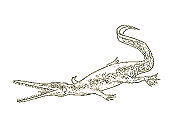Gondwanaland
A. Meet Mesosaurus, a small reptile which lived in fresh-water lakes and streams millions of years ago during the lower Permain age. Mesosaurus has had a big impact on how we view our planet, because he helped to prove the existence of the super-continent called Gondwanaland.

B. Every schoolchild has probably looked at a map of the earth and noticed how Africa and South America fit together like pieces of a giant jigsaw, yet until just over a hundred and fifty years ago, no-one believed that this was more than an odd coincidence. It seemed impossible that the massive continents of the earth could ever be moved, let alone so far apart that they ended up half a planet from each other.
C. Nevertheless, in 1912 Alfred Wegener, a German meteorologist came up with the theory that the continents of the earth had all existed in a single mass, which he called Pangaea (which is Greek for ‘all the world”) Later researchers decided that Pangaea had been two continents, one to the north of the other, which had existed about 250 million years ago. From the geological evidence found in the Gondwana area of India, an Austrian geologist, Eduard Suess coined the name ‘Gondwanaland’ for the southern supercontinent, of which India was once a part. (The northern continent was called Lurasia.)
D. For many years super-continents were regarded as an interesting theory, but no-one knew how it might work in reality. Then the discovery of the mechanisms of plate tectonics showed how continents might drift across the face of the globe. Once it was accepted that the continents were floating on currents of lava, more evidence became apparent. A particular type of an early plant, the seed fern, was found on continents now scattered about the southern hemisphere of the world, as were tillates, a deposit left by glaciers in the Permo-Carboniferous era of 520 million years ago. And Mesosaurus, the little fresh-water reptile, left his remains in West Africa and Brazil. Since Mesosaurus had no way of crossing the Atlantic, researchers realized that it could not be coincidence that this reptile had left remains in exactly the place where Africa and South America fit together so neatly.
E. By investigating similarities in animal fossils, different types of plants found in the southern hemisphere but not in the northern hemisphere, and patterns of rock formations, researchers have managed to put the continents of modern-day earth together like a huge jigsaw to make up the vanished super-continent. Sometimes rock formations can be seen to break off at the ocean’s edge, to carry on once more thousands of miles away on another continent. The evidence shows that not only were Africa and South America once joined to Antartica, but so were India and Australia, parts of south Western Europe, and Florida.
F. Although Gondwanaland was located in the far southern hemisphere of the planet, where Antarctica remains today, the climate was much warmer, and we know that huge forests grew there. These forests, fossilized into coal, supply many Indians with energy today. The land animals were adapted to life on their cool continent, with its long dark winter days. Some of the best known dinosaurs, such as Stegosaurus, Triceratops, and Tyrannosaurus lived on the northern continents, but Gondwanaland also had some fearsome predators such as Abelisaurus, a large meat-eater that lived during the cretaceous period. The seas were populated with fish called placoderms, a name which they get from their skin, which was so thick that they were practically armoured.
G. The break-up of Gondwanaland had huge consequences for planet earth as we know it now. In geological terms, India has been a sprinter. Breaking from Gondwanaland the sub-continent drifted rapidly northward from the south pole, finally smashing into Asia about 45 million years ago in a collision that raised the Himalayas.
H. When South America split off about 30 million years ago the effect was even more dramatic. Cold Antarctic water no longer mixed with warmer seas when pushed northward by the south American landmass. Instead it circled the pole getting colder and colder, until Antartica lost its vegetation and animal life, and became the barren icy wilderness it is today.
Questions 1-8
The reading passage has eight paragraphs.
There are 8 paragraph Headings bellow and on your answer sheet write the appropriate paragraph numbers (A-H) from questions 1-8.
1 Finding the evidence
2 The living continent
3 Small but significant
4 Making modern Antartica
5 Putting it all together
6 Joining another continent
7 An impossible idea
8 What’s in a name?
Questions 9-13
Choose from the phrases below to complete sentences which best summarize the points made by the writer.
Write the name of the phrases (A -J) that completes the point mentioned from 9-13.
NB. There are more phrases than you need.
9 For many years the existence of Gondwanaland
10 The discovery of plate tectonics
11 Evidence for Gondwanaland
12 In the past Gondwanaland
13 The break-up of Gondwanaland
| A. was dominated by the theories of European scientists B. had a large population of plants and animals C. demonstrated that continents can indeed drift apart D. partly explains why earthquakes and volcanoes happen E. was because Mesosaurus existed on two modern continents F. has been found in geological formations and fossils G. smashed into the Asian landmass 45 million years ago H. was nothing but speculation I. had huge effects on the climate of the Earth J. was believed to be a legendary lost continent |
How many questions did you get right in this reading test? Input it into the IELTS score calculator and see your IELTS reading band scores.
Related IELTS Resources
Take a practice test to find out what is your current weakness in terms of IELTS scale and allow more time to improve your weak spots. The following IELTS resources will help you to develop your skills faster:
